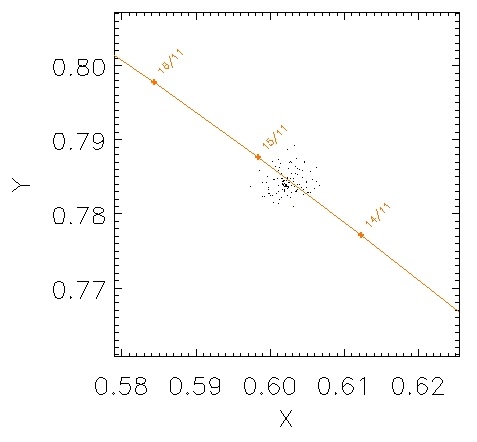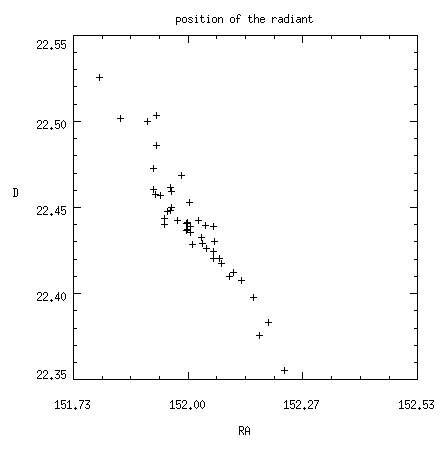New calculations run by Jérémie Vaubaillon (Paris Observatory, IMCCE) highlighted a potential new meteor outburst prediction for the 2024 Leonids. The 2024 IMO Meteor Shower Calendar has been updated accordingly.
In 2024, the “normal” maximum of the Leonid meteor shower is expected to occur on November 17, 04h UT, with ZHR ~ 15-20 (Mikhail Maslov expects slightly enhanced rates). In addition to this, some additional outbursts were expected :
- Mikiya Sato find an encounter with the 1733 dust trail on November 19/20, between 23h 53min and 00h 54min UT. The minimum distance is quite large (-0.0002 au), and ejection velocity being high, the rates shall be low.
- initial predictions by Jérémie Vaubaillon highlighted encounters with very old trails (ejected about 1000 years ago) of 55P/Tempel-Tuttle on November 14, 16h 37min UT.
But after checking, one trail has been underviewed : on that date and time, the Earth orbit should cross the 1633 trail (which caused the 2001 meteor storm) of the comet (Figures 1 & 2) on November 14, 16h 37min UT too.


As the comet is currently far away from the perihelion position, and that the trail is composed of small meteoroids (< 1 mm), rates are hard to predict. Even if rates are high, the meteor showers should be composed of faint meteors, and the bright waning gibbous Moon will be a considerable nuisance. But anyway, this potential outburst is worth monitoring, in case anything happens. Especially because the Earth should cross it again in 2034…




 You saw something bright and fast? Like a huge shooting star? Report it: it may be a fireball.
You saw something bright and fast? Like a huge shooting star? Report it: it may be a fireball.  You counted meteors last night? Share your results with us!
You counted meteors last night? Share your results with us!  You took a photo of a meteor or fireball? You have a screenshot of your cam? Share it with us!
You took a photo of a meteor or fireball? You have a screenshot of your cam? Share it with us!  You caught a meteor or fireball on video? Share your video with us!
You caught a meteor or fireball on video? Share your video with us!
4 comments
Hi Karl, is this still anticipated? Any new info? Thanks
Dear Bray,
Yes, it is still planned, and thus worth to check for those who will have the chance to be in the nightime at the predicted outbursts timings.
First potential activity enhancement, associated to 1633 and much older trails is now 30 hours from now!
Good luck!
Karl
Hi Karl,
No worries, unfortunately the radiant won’t be showing til around 1hr and a half after that 16h37min UT here. The time for the 19th/20th will be daylight.
Hope others are able to see something/count!
Cheers
Looking through old documents with predictions for the 2001 Leonid storms – of which there were two, separated by seven hours – I see the 1633 trail mentioned by only one of several groups and even then only as a minor contributor to the second peak: is that with hindsight interpreted differently?